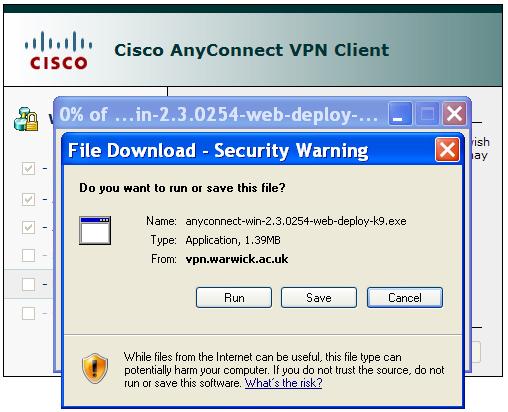

It will send an alert when things go bad and when they get better.
#Cisco vpn setup temp windows
Nagios performance monitoring application or a SNMP network monitoring tools and server monitoring tools can be used to monitor various network device types such as switches, routers, firewalls as well as application performance monitoring on Linux and monitoring Windows service for host up/down status, CPU usage, memory usage, switch or router interface up/down status , ping monitor and more.

#Cisco vpn setup temp install
(Valid CCO login is requiredģ) Extract the vpnclient-win-msi-5.0.xx.xxxx-k9.exe to a network share (we used \\share3\software) and put the install files into a directory (we used \cisco\secure vpn client\2000-xp-vista\current).CentOS 7, Linux, Nagios, RHEL 7 1.
#Cisco vpn setup temp software
"c:\temp\vpn client\vpnclient_setup.msi" REBOOT=Supress /qbĬmd /c mkdir "c:\program files\cisco systems\vpn client\Profiles"Ĭopy "\\share3\software\cisco\secure vpn client\*.pcf" "c:\program files\cisco systems\vpn client\profiles\".ġ) Download the current VPN Client Software for 2000/XP/Vista - Microsoft Installer from Cisco. pcf files, for our environment at the end of the script.Ĭopy "\\share3\software\cisco\secure vpn client\2000-xp-vista\current\" "c:\temp\vpn client\" (Valid CCO login is requiredÂ…)Ģ) Extract the downloaded vpnclient-win-msi-5.0.xx.xxxx-k9-bundle.exeģ) Extract the vpnclient-win-msi-5.0.xx.xxxx-k9.exe to a network share (we used \\share3\software) and put the install files into a directory (we used “\cisco\secure vpn client\2000-xp-vista\current”).Ĥ) Also, we copy over exported connection entries. Steps we used are:ġ) Download the current “VPN Client Software for 2000/XP/Vista - Microsoft Installer” from Cisco. Because the network connection is dropped a few times during the install, this script copies the install files to the local system first. Here is a script we made to deploy the current v5.0.x Cisco Secure VPN Client. In my testing I found that ZEN could be configured to suppress the reboot prompt (Distribution Options | Options - set "Reboot" to "Never" and "Prompt for Reboot" to "Don't prompt") and the client would still work without a reboot. Since we deploy this in the shop before the laptop leaves the building, it's not a big deal for us corporations needing something more discreet might need to look into that further. Note that during deployment a cmd.exe window appears as files are being copied, even if the interaction is set to silent. Since ZEN caches the installer, the little hack that avoided checking if the installer was running from the network is sufficient to avoid a 1603 error on deployment. This app was then deployed silently via ZENworks 7.0.1. I used Orca for the network install transform, and AdminStudio for the profiles transform. You can also specify the \RunAtLogon (1=bring up window before logging into windows) and \DialerDisconnect (1=disconnects VPN when logging off) options if you want. The INI file specifies, among other things, the default profile (\DefaultConnectionEntry). I also created a second transform (vpnclient_profiles.mst) to install our connection profiles (to Program Files\Cisco Systems\VPN Client\Profiles\, which is where the client checks by default for connection profiles) and to create vpnclient.ini in the Program Files\Cisco Systems\VPN Client\ folder. In order to allow the installation to proceed from the network (which Cisco recommends against, because the installation momentarily knocks network connectivity off at the end of the install) create a transform - I called it allow_network_install.mst - using Orca and modify the following under the "CustomAction" table:ĬsCaDll_GetInstallDriveType1 - DELETE ROW I extracted vpnclient_setup.msi from using 7-zip.


 0 kommentar(er)
0 kommentar(er)
